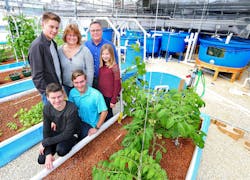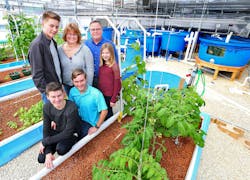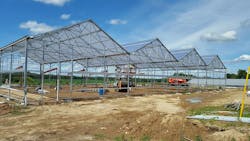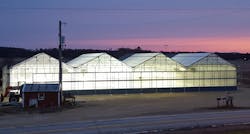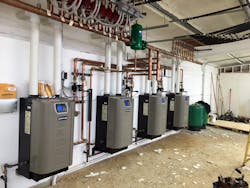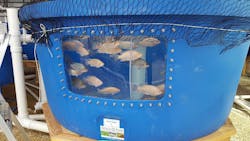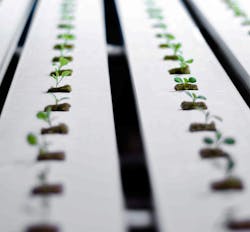Farm Family Cultivating New Aquaponics Venture With Help of Boilers
The Goodenoughs—Tim, wife Bonny, and their four children—are a fourth- and fifth-generation farm family from Mindoro, Wis. They had been growing soybeans and corn for some time when, several years ago, they concluded a change was in order.
“Input prices were high, grain prices were fluctuating constantly, and Mother Nature was throwing us curveballs,” Tim recalled.
Intrigued by the idea of fish farming since observing such an operation during an American Soybean Association trip to South America several years earlier, Tim began researching aquaponics, a system combining aquaculture—the raising of aquatic animals—and hydroponics—the cultivation of plants in water—in a closed-loop system.
In 2014, the Goodenoughs were ready to give aquaponics a go, purchasing an existing four-section, 13,600-sq-ft greenhouse in Eau Claire, Wis. The family spent three months disassembling the greenhouse and transporting it piece by piece to their farm.
The next year, the Goodenoughs finalized construction plans for the greenhouse as well as a lean-to for mechanical equipment. Concrete piers were poured and support posts and trusses were set.
Reconstruction of the greenhouse began in 2016. The Goodenoughs worked in tandem with a construction crew for six months until the facility was completed. Ron Hammes Refrigeration, La Crosse, Wis.-based refrigeration and HVAC specialists, installed the heating equipment and piping.
Advanced Environmental Controls
With wintry Wisconsin weather setting in, the heating system needed to be installed quickly.
“We required air temperatures of about 70 degrees in the greenhouse year-round and water temperatures between 70 to 75 degrees for the fish and plants to thrive,” Bonny said.
Another important concern: The greenhouse structure, which consists of lightweight polycarbonate, could collapse under the weight of a heavy snowfall.
“Snow could wreak havoc on our structure, and so it was imperative to get the heating system online as soon as possible,” Tim said.
To meet project parameters, James Hammes, president of Ron Hammes Refrigeration, recommended the installation of four 399-MBH Weil-McLain Evergreen gas boilers with primary-secondary pumping. A master boiler controls the modulation and sequencing of boilers on the network to achieve the desired system supply temperature.
“With the automatic-sequencing feature, the boilers communicate directly with one another so they sequence themselves and rotate as needed,” Hammes said. “They operate to optimize energy use and efficiencies. When heat is required, the boilers will stage on one by one as needed.”
The Evergreen units were tied to existing heat exchangers on site and installed as part of a Wadsworth Controls system that monitors external temperature, wind speed and direction, precipitation and humidity, and internal factors such as temperature and humidity.
To maintain conditions, the Wadsworth Controls system cycles the boilers, heat exchangers, and grow lights on and off and opens and closes vents and shade cloth based on the amount of sunlight. It is designed to keep humidity and temperature levels inside the grow operation within targeted parameters.
“We are essentially trying to create the longest summer day of the season year-round in the greenhouse,” Tim said. “The vents, lights, and shade cloth are all computerized and move automatically to maintain conditions.”
With the heating system in place, the nursery was filled with 130 tilapia and several varieties of vegetables in early December 2016. When all are filled, the tanks will hold approximately 2,300 fish.
Results
The four Evergreen boilers maintain proper temperatures in the building, while providing supplemental heat for the fish tanks and nurseries.
“The boilers are very energy-efficient and will cycle on and off as needed,” Tim said. “They typically shut off when the temperature outside is 65 and higher.”
The boilers also allow the greenhouse to stay snow-free all winter.
“We had some major snowfalls this last season, but it always melted and never accumulated on the roof of the greenhouse,” Tim said.
The Goodenoughs’ Floating Gardens LLC is producing approximately 250 heads of lettuce a day, with varieties of romaine, butterhead, and summer crisp. The family also is growing swiss chard, pea pods, string beans, kale, tomatoes, and radishes.
“We harvested our first gourmet-lettuce crop in April, and we will begin selling freshly harvested tilapia mid-year, when the fish have reached market weight of about 1½ lb,” Bonny said.
The Goodenoughs sell their products at their on-site market and to farmers’ markets, local restaurants, schools, and grocery stores.
“We believe aquaponics is the new face of farming, as it is sustainable, healthier, and can supply more food per acre than traditional methods,” Tim said. “We are very happy with the system we have in place, and the Weil-McLain boilers are a key component in making this efficient growing method a success.”
